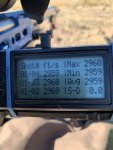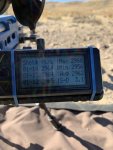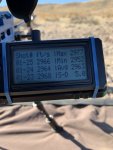I realize there are several older threads on this topic. Many contain useful information, but there are Multiple contradictions as well. And not a lot of hard data. So: Decided to start a new thread.
Conducted a primer test for an MPA comp rifle in 6.5 CM. Hornady 140 ELDM projectiles, weight sorted FL sized Alpha brass, trimmed and fully prepped, a fairly high charge of H4350 (still below book max) weighed to 0.02 grain accuracy (one kernel of powder) via FX120i scale, while using CCI450 magnum small rifle primers, weighed on the same AND lab scale in milligram mode.
Brass was fully prepped and FL sized and shot well before. Alpha brass is thicker and has less internal capacity, but it has very consistent internal (water) volume, which ensures good reloading results.
My crony (LabRadar) results showed that primer weight has a measurable effect on MV: Primer weight ranged from 235 milligrams (3.63 grains) to 241 milligrams (3.72 grains). That 6 milligram (0.092 grain) range represents a 2.5% variation. The scale is accurate enough (to 0.02 grains or 0.001 grams = 1 milligram). It can pick up these small differences in primer weight. [As long as you prevent a draft: Close the door and turn off the AC. Btw: A standard powder scale with 0.1 grain resolution will not be very effective here.]
Collected 20 data points (threw out the first 3 ‘cold bore’ / fouling shots, which always tend to be slower). Assumed that three fouling shots are in fact sufficient. Data seems to prove this out. Fired rounds slowly and in random order, and barrel temperature was kept warm but not hot (around 120 degree F, via the temperature strip on the barrel). Luke warm barrel at all times, post fouling shots.
Then did a linear regression of the 20 data points. R-square is an indication of degree of fit, and in general that varies between 0 (no relationships at all) to 1.0 (perfectly correlated). A number like 0.7 or higher would be considered good. In this case, R-square was not particularly good, as it was only 0.23. Roughly indicating that my simple linear math model can only explain 23% of the variability in speed. So NOT a great model! [ironically: If i had a really bad batch of primers to work with that had much larger weight variation, my results would have been more convincing!]
Based on the model, speed increased by 11.5 fps over this narrow 2.5% range due to increased primer weight, or 2.33 fps per additional milligram of primer weight.
Note: Random ordered the cases, so speed results are not biased by a progressive increase in barrel temp, and kept the barrel temp lukewarm. Shot slowly from a sturdy steel bench, in a fairly constant 12 mph wind (fairly heavy wind, but direction was mostly constant).
Did not try to shoot separate groups for each weight range. The groups were shot at 100 yards, from a sturdy bipod, with an empty thick folded sports sock below the bag rider attached to the chassis. Group size varied between 0.35” and 0.65” with some horizontal deviation creeping into it due to lack of a proper sandbag (and not using free recoil). Yes i (slightly) pulled a few shots, mostly sideways, which increased horizontal deviation. Even so: Groups were adequate for what i do.
SD for all 20 rounds was 7.6 fps, which was suprisingly low given that i intentionally loaded ammo with the widest possible primer weight range. [Says a lot about the quality of this batch of CCI primers.]
If i could get a current BR champion to shoot these rounds in an underground 100 yard tunnel, i would have liked to report group size per 2 milligram weight range.... Any volunteers who own and operate a 100 or better yet a 300 yard underground tunnel, please let me know. ?
In short: The effect is real. Increased primer weight makes the bullet go faster. Other threads on this topic have already indicated (proven?) that the weight difference is all in the amount of explosive material inside the primer, not the metal components (primer cup or anvil).
Calculated how much SD would have improved if the effect of primer weight variation was completely removed: SD would have reduced from 7.6 fps to 6.7 fps for this group of 20 shots. Is that enough to worry about? Probably not.
How much of an effect does the primers actually have? For my rifle, powder, bullet and primer choice, i get 2.33 additional fps for each additional milligram of primer weight. Since primer weight increased by only 5 milligrams in this batch, or 2.3%, speed increased by only about 12 fps (or 0.4%). Not so much!
So should you weigh all your primers and sort them? Spend an entire week-end on this mind numbing task? [I did. It was boring as hell!]
OK: Trying to be serious and even handed here:
1) If you are competing for a BR championship or in an ELR event, and you are one win away from victory, then likely yes, you should at least consider weight sorting all your components, primers included. [Probably out of an abundance of caution.] In this scenario you are already getting ES under 10 and SD around 3 fps. So going up from 3 to 4 fps might cost you a point or two at 1000 yards.
2) If your SD is above 10 fps and ES is above 35 fps, the benefit of primer sorting will be minimal, assuming your batch of primers is as good or better than the one CCI batch that i tested. But how do you know for sure how good (or bad) your batch really is, unless you have already fired 30-100 rounds using this new batch, and your SD is holding close to your historical results? [Expensive way to determine primer batch quality.]
3) Recommendation: When you buy a new batch of 10,000 primers, do a random test and weigh 30-40 primers total from different boxes. Use a good scale with better than 0.1 grain resolution (0.05 gn or better). Compare the measured weight range (weight ES) to what you have historically considered adequate. Record the result in your reloading book. If it is about the same as before, STOP weighing primers and continue shooting them. If the new batch is significantly worse, say 2x or more, then get rid of that batch. Sell it to somebody who loads 200 yard hunting ammo.
My personal conclusion here is that i am going to do a quick check on new batches, and if they are good, i will not weight sort primers anymore. For what i do, there is not enough benefit in dropping SD by 0.9 fps.
If and when i get into the ELR game, i will weight sort primers again.
Namib
Sent from my iPhone
Conducted a primer test for an MPA comp rifle in 6.5 CM. Hornady 140 ELDM projectiles, weight sorted FL sized Alpha brass, trimmed and fully prepped, a fairly high charge of H4350 (still below book max) weighed to 0.02 grain accuracy (one kernel of powder) via FX120i scale, while using CCI450 magnum small rifle primers, weighed on the same AND lab scale in milligram mode.
Brass was fully prepped and FL sized and shot well before. Alpha brass is thicker and has less internal capacity, but it has very consistent internal (water) volume, which ensures good reloading results.
My crony (LabRadar) results showed that primer weight has a measurable effect on MV: Primer weight ranged from 235 milligrams (3.63 grains) to 241 milligrams (3.72 grains). That 6 milligram (0.092 grain) range represents a 2.5% variation. The scale is accurate enough (to 0.02 grains or 0.001 grams = 1 milligram). It can pick up these small differences in primer weight. [As long as you prevent a draft: Close the door and turn off the AC. Btw: A standard powder scale with 0.1 grain resolution will not be very effective here.]
Collected 20 data points (threw out the first 3 ‘cold bore’ / fouling shots, which always tend to be slower). Assumed that three fouling shots are in fact sufficient. Data seems to prove this out. Fired rounds slowly and in random order, and barrel temperature was kept warm but not hot (around 120 degree F, via the temperature strip on the barrel). Luke warm barrel at all times, post fouling shots.
Then did a linear regression of the 20 data points. R-square is an indication of degree of fit, and in general that varies between 0 (no relationships at all) to 1.0 (perfectly correlated). A number like 0.7 or higher would be considered good. In this case, R-square was not particularly good, as it was only 0.23. Roughly indicating that my simple linear math model can only explain 23% of the variability in speed. So NOT a great model! [ironically: If i had a really bad batch of primers to work with that had much larger weight variation, my results would have been more convincing!]
Based on the model, speed increased by 11.5 fps over this narrow 2.5% range due to increased primer weight, or 2.33 fps per additional milligram of primer weight.
Note: Random ordered the cases, so speed results are not biased by a progressive increase in barrel temp, and kept the barrel temp lukewarm. Shot slowly from a sturdy steel bench, in a fairly constant 12 mph wind (fairly heavy wind, but direction was mostly constant).
Did not try to shoot separate groups for each weight range. The groups were shot at 100 yards, from a sturdy bipod, with an empty thick folded sports sock below the bag rider attached to the chassis. Group size varied between 0.35” and 0.65” with some horizontal deviation creeping into it due to lack of a proper sandbag (and not using free recoil). Yes i (slightly) pulled a few shots, mostly sideways, which increased horizontal deviation. Even so: Groups were adequate for what i do.
SD for all 20 rounds was 7.6 fps, which was suprisingly low given that i intentionally loaded ammo with the widest possible primer weight range. [Says a lot about the quality of this batch of CCI primers.]
If i could get a current BR champion to shoot these rounds in an underground 100 yard tunnel, i would have liked to report group size per 2 milligram weight range.... Any volunteers who own and operate a 100 or better yet a 300 yard underground tunnel, please let me know. ?
In short: The effect is real. Increased primer weight makes the bullet go faster. Other threads on this topic have already indicated (proven?) that the weight difference is all in the amount of explosive material inside the primer, not the metal components (primer cup or anvil).
Calculated how much SD would have improved if the effect of primer weight variation was completely removed: SD would have reduced from 7.6 fps to 6.7 fps for this group of 20 shots. Is that enough to worry about? Probably not.
How much of an effect does the primers actually have? For my rifle, powder, bullet and primer choice, i get 2.33 additional fps for each additional milligram of primer weight. Since primer weight increased by only 5 milligrams in this batch, or 2.3%, speed increased by only about 12 fps (or 0.4%). Not so much!
So should you weigh all your primers and sort them? Spend an entire week-end on this mind numbing task? [I did. It was boring as hell!]
OK: Trying to be serious and even handed here:
1) If you are competing for a BR championship or in an ELR event, and you are one win away from victory, then likely yes, you should at least consider weight sorting all your components, primers included. [Probably out of an abundance of caution.] In this scenario you are already getting ES under 10 and SD around 3 fps. So going up from 3 to 4 fps might cost you a point or two at 1000 yards.
2) If your SD is above 10 fps and ES is above 35 fps, the benefit of primer sorting will be minimal, assuming your batch of primers is as good or better than the one CCI batch that i tested. But how do you know for sure how good (or bad) your batch really is, unless you have already fired 30-100 rounds using this new batch, and your SD is holding close to your historical results? [Expensive way to determine primer batch quality.]
3) Recommendation: When you buy a new batch of 10,000 primers, do a random test and weigh 30-40 primers total from different boxes. Use a good scale with better than 0.1 grain resolution (0.05 gn or better). Compare the measured weight range (weight ES) to what you have historically considered adequate. Record the result in your reloading book. If it is about the same as before, STOP weighing primers and continue shooting them. If the new batch is significantly worse, say 2x or more, then get rid of that batch. Sell it to somebody who loads 200 yard hunting ammo.
My personal conclusion here is that i am going to do a quick check on new batches, and if they are good, i will not weight sort primers anymore. For what i do, there is not enough benefit in dropping SD by 0.9 fps.
If and when i get into the ELR game, i will weight sort primers again.
Namib
Sent from my iPhone
Last edited:








